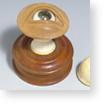Displayed in this room are various instruments used in some of the scientific disciplines that began to develop in the second half of the 17th century. At this time meteorology was progressing rapidly, thanks to perfected instrumentation for measuring variations in thermometric, barometric and hygrometric values. The systematic use of increasingly improved microscopes led to striking achievements in the fields of biology and entomology. Francesco Redi, a pioneer in these fields of research, brilliantly combined refined strategies of experimentation with scrupulous microscopic observations. Telescopes of ever greater size and more complex optical systems were also being produced by expert instrument makers. With such progress in telescopic instrumentation, astronomical observations led to crucially important discoveries.
Optics: Lenses, Microscopes and the Eye
In the 17th century studies in geometrical optics, both theoretical and practical, became increasingly refined. The Medicean collection was enriched with ...
(16 objects)
Perfecting the Telescope
The Medicean collections document the history of the telescope's early evolution, starting from Galileo's immediate successors, such as Ippolito Francini ...
(26 objects)
Meteorology: Thermology, Barometers and Hygrometers
In the wake of the meteorological network founded by the Accademia del Cimento, three instruments were perfected to detect the characteristics of atmospheric ...












